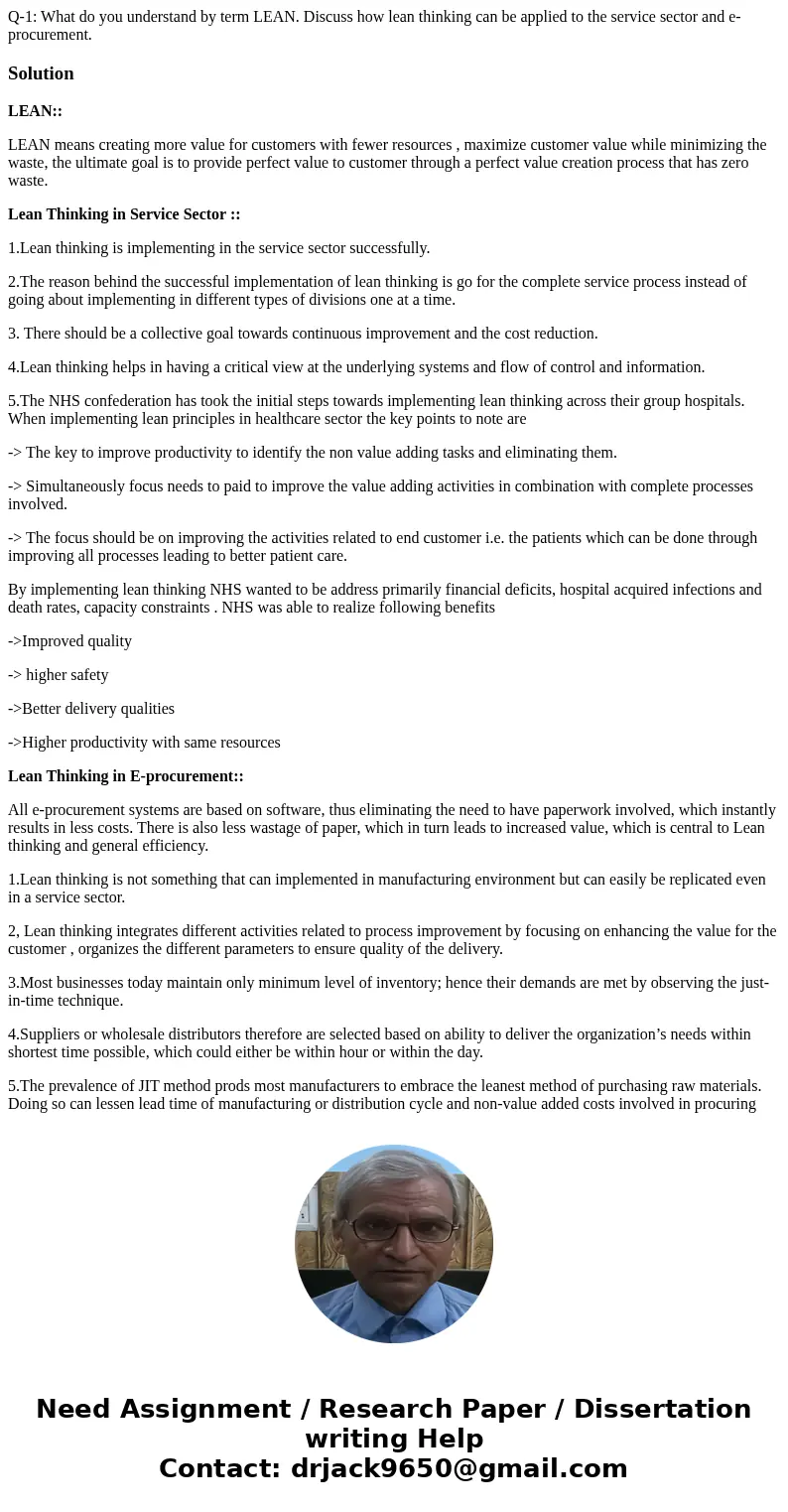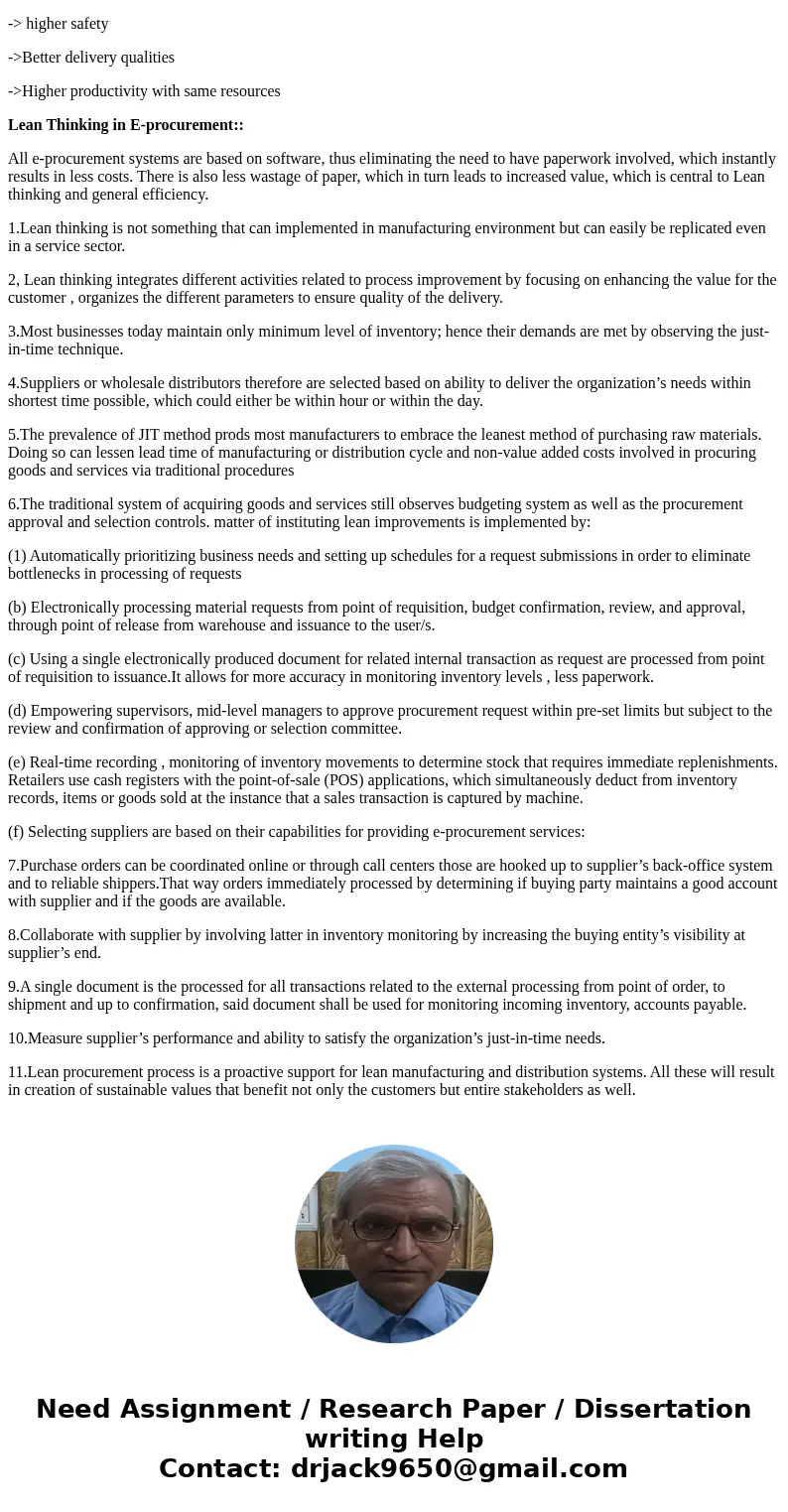Q1 What do you understand by term LEAN Discuss how lean thin
Q-1: What do you understand by term LEAN. Discuss how lean thinking can be applied to the service sector and e-procurement.
Solution
LEAN::
LEAN means creating more value for customers with fewer resources , maximize customer value while minimizing the waste, the ultimate goal is to provide perfect value to customer through a perfect value creation process that has zero waste.
Lean Thinking in Service Sector ::
1.Lean thinking is implementing in the service sector successfully.
2.The reason behind the successful implementation of lean thinking is go for the complete service process instead of going about implementing in different types of divisions one at a time.
3. There should be a collective goal towards continuous improvement and the cost reduction.
4.Lean thinking helps in having a critical view at the underlying systems and flow of control and information.
5.The NHS confederation has took the initial steps towards implementing lean thinking across their group hospitals. When implementing lean principles in healthcare sector the key points to note are
-> The key to improve productivity to identify the non value adding tasks and eliminating them.
-> Simultaneously focus needs to paid to improve the value adding activities in combination with complete processes involved.
-> The focus should be on improving the activities related to end customer i.e. the patients which can be done through improving all processes leading to better patient care.
By implementing lean thinking NHS wanted to be address primarily financial deficits, hospital acquired infections and death rates, capacity constraints . NHS was able to realize following benefits
->Improved quality
-> higher safety
->Better delivery qualities
->Higher productivity with same resources
Lean Thinking in E-procurement::
All e-procurement systems are based on software, thus eliminating the need to have paperwork involved, which instantly results in less costs. There is also less wastage of paper, which in turn leads to increased value, which is central to Lean thinking and general efficiency.
1.Lean thinking is not something that can implemented in manufacturing environment but can easily be replicated even in a service sector.
2, Lean thinking integrates different activities related to process improvement by focusing on enhancing the value for the customer , organizes the different parameters to ensure quality of the delivery.
3.Most businesses today maintain only minimum level of inventory; hence their demands are met by observing the just-in-time technique.
4.Suppliers or wholesale distributors therefore are selected based on ability to deliver the organization’s needs within shortest time possible, which could either be within hour or within the day.
5.The prevalence of JIT method prods most manufacturers to embrace the leanest method of purchasing raw materials. Doing so can lessen lead time of manufacturing or distribution cycle and non-value added costs involved in procuring goods and services via traditional procedures
6.The traditional system of acquiring goods and services still observes budgeting system as well as the procurement approval and selection controls. matter of instituting lean improvements is implemented by:
(1) Automatically prioritizing business needs and setting up schedules for a request submissions in order to eliminate bottlenecks in processing of requests
(b) Electronically processing material requests from point of requisition, budget confirmation, review, and approval, through point of release from warehouse and issuance to the user/s.
(c) Using a single electronically produced document for related internal transaction as request are processed from point of requisition to issuance.It allows for more accuracy in monitoring inventory levels , less paperwork.
(d) Empowering supervisors, mid-level managers to approve procurement request within pre-set limits but subject to the review and confirmation of approving or selection committee.
(e) Real-time recording , monitoring of inventory movements to determine stock that requires immediate replenishments. Retailers use cash registers with the point-of-sale (POS) applications, which simultaneously deduct from inventory records, items or goods sold at the instance that a sales transaction is captured by machine.
(f) Selecting suppliers are based on their capabilities for providing e-procurement services:
7.Purchase orders can be coordinated online or through call centers those are hooked up to supplier’s back-office system and to reliable shippers.That way orders immediately processed by determining if buying party maintains a good account with supplier and if the goods are available.
8.Collaborate with supplier by involving latter in inventory monitoring by increasing the buying entity’s visibility at supplier’s end.
9.A single document is the processed for all transactions related to the external processing from point of order, to shipment and up to confirmation, said document shall be used for monitoring incoming inventory, accounts payable.
10.Measure supplier’s performance and ability to satisfy the organization’s just-in-time needs.
11.Lean procurement process is a proactive support for lean manufacturing and distribution systems. All these will result in creation of sustainable values that benefit not only the customers but entire stakeholders as well.


 Homework Sourse
Homework Sourse